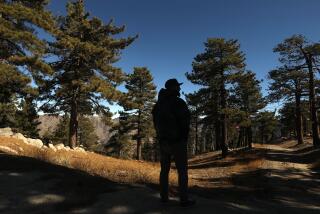The Molehill Club?
- Share via
The Sierra Club without rock climbing or mountaineering? As well the Audubon Society without birds, or the Wilderness Society without trees. Climbing has been the heart and soul of the San Francisco-based organization founded by naturalist-mountaineer John Muir and others in 1892. Generations of Californians learned to love the Sierra Nevada through the club’s wilderness trips. Muir’s concept was to get people into the mountains so that they could really come to know them. By knowing the mountains, club members would fight to save the wilderness.
Thousands have learned to climb rock, ice and snow safely through club programs. But now the club’s directors have voted to ban club-sanctioned climbing because of soaring insurance rates. As reported by The Times’ Bettina Boxall, the Los Angeles-area chapter has dismantled part of its mountaineering course and dropped about 300 trips from its outing program. Protesting members are threatening to run a pro-climbing slate of candidates for the board.
But supporters of the ban argue that the club no longer can afford the luxury of an insurance rate increase of at least $325,000 a year in behalf of a minority of members, out of a national roster of nearly 500,000, who want to engage in roped climbing. Ironically, those who supported the ban include former executive director David Brower, a pioneer of rock climbing in Yosemite and the Sierra. Brower said that members can go climb on their own while the club works to save “the damn mountains they want to climb.” There still will be wilderness trips, but none onto the heights where ropes or ice axes are required, and no instruction courses for beginners.
The Sierra Club no longer is just a California society, of course. It has broadened its environmental horizon to national and global issues, particularly since Brower’s tenure as executive director, and has developed lobbying clout in Washington and state capitals. The climbing decision is regrettable, but understandable.
Club members were at the center of the development of high-angle, roped rock climbing in the West in 1931 when Harvard’s Robert L. M. Underhill brought his Alpine training to the Sierra at the invitation of Francis Farquhar. The summer’s highlight was the Aug. 16 first ascent of the east face of 14,495-foot Mt. Whitney by Underhill, Norman Clyde, Jules Eichorn and Glen Dawson. Not difficult by today’s standards, the east face remains a classic route. The club’s Rock Climbing Section was soon formed, and the club later published “Belaying the Leader,” the primer and bible for a generation of California climbers who ultimately took their Sierra-learned skills to the summits of the Alps, the Cordilleras of South America, to Canada, Alaska and the Himalayas.
The ban will not eliminate the club’s presence in the Sierra heights, however. Every major Sierra peak has a metal box stamped with the Sierra Club seal and containing a summit register to be signed by all who make the top. But on the most difficult, and best, peaks in the Sierra that no longer will include official Sierra Club groups.
More to Read
Sign up for The Wild
We’ll help you find the best places to hike, bike and run, as well as the perfect silent spots for meditation and yoga.
You may occasionally receive promotional content from the Los Angeles Times.






